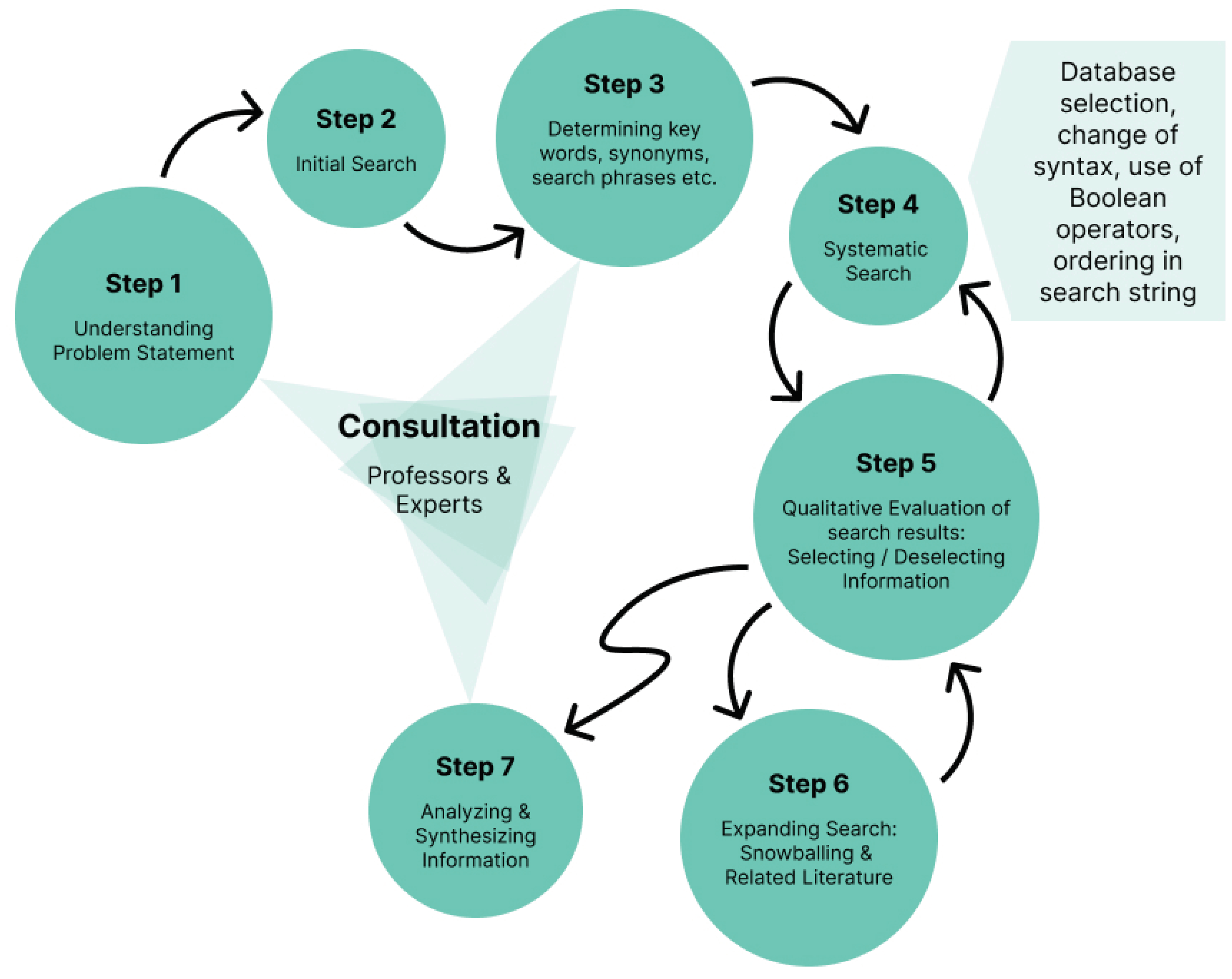Submitted:
20 March 2024
Posted:
21 March 2024
You are already at the latest version
Abstract
Keywords:
1. Introduction
- What types of information sources are available regarding building defects?
- What are the main purposes for the scientific studies of building defects?
- How can the findings from the literature survey be used further?
2. Materials and Methods
2.1. Scoping Studies
- Identifying the research questions;
- Identifying relevant studies;
- Study selection;
- Charting the data;
- Collating, summarizing, and reporting the results.
2.2. Reflexive Thematic Analysis
- Becoming familiar with the data;
- Generating initial codes;
- Searching for themes;
- Reviewing themes;
- Defining themes;
- Writing-up.
3. Results
3.1. General Overview of the Literature
3.2. Type of Information Source
3.2.1. Insurance Company Database
3.2.2. Private Databases
3.2.3. Questionnaire Surveys
3.2.4. Building Surveys
3.2.5. Lawsuits
3.2.6. Client Complaint Forms
3.2.7. Maintenance Reports
3.3. Main Purpose and Findings for the Studies
3.3.1. Design Challenges
3.3.2. Identification
3.3.3. Overview of Typical Defects
3.3.4. Classification
3.3.5. Building Maintenance Management
3.3.6. Quality Management
3.3.7. Systematization in Data Collection
4. Discussion
4.1. Type of Information Source
4.2. Main Purpose
4.3. Further Use of the Literature Findings
5. Conclusions
Supplementary Materials
Author Contributions
Funding
Data Availability Statement
Acknowledgments
Conflicts of Interest
References
- Love, P.E.D.; Li, H. Quantifying the Causes and Costs of Rework in Construction. Constr. Manag. Econ. 2000, 18, 479–490. [Google Scholar] [CrossRef]
- Sandanayake, M.; Yang, W.; Chhibba, N.; Vrcelj, Z. Residential Building Defects Investigation and Mitigation – a Comparative Review in Victoria, Australia, for Understanding the Way Forward. Eng. Constr. Archit. Manag. 2021, 29, 3689–3711. [Google Scholar] [CrossRef]
- Nielsen, J.; Hansen, M.H. Svigt i Byggeriet. Økonomiske Konsekvenser Og Muligheder for En Reduktion; Erhvervs- og Byggestyrelsen: Copenhagen, Denmark, 2004. [Google Scholar]
- Ingvaldsen, T. Byggskadeomfanget i Norge. Prosjektrapport 163.; Norges byggforskningsinstitutt: Oslo, Norway, 1994. [Google Scholar]
- Norsk takst. Norges TakseringsForbund Tar Tempen På Norske Bygg; 2007. [Google Scholar]
- Lisø, K.R.; Kvande, T.; Thue, J.V. Learning from Experience - An Analysis of Process Induced Building Defects in Norway. In Research in Building Physics and Building Engineering; Taylor & Francis Group: London, United Kingdom, 2006; pp. 425–432. ISBN 978-0-415-41675-7. [Google Scholar]
- Chew, M.Y.L.; De silva, N. Maintainability Problems of Wet Areas in High-Rise Residential Buildings. Build. Res. Inf. 2003, 31, 60–69. [Google Scholar] [CrossRef]
- De Vos, J.; Blommaert, A.; Van Den Bossche, N. Statistical Analysis on Belgian Building Defects. In Proceedings of the Current topics and trends on durability of building materials and components, Barcelona, Spain, 20 October 2020. [Google Scholar]
- Van Den Bossche, N.; Blommaert, A.; Daniotti, B. The Impact of Demographical, Geographical and Climatological Factors on Building Defects in Belgium. Int. J. Build. Pathol. Adapt. 2022, 41. [Google Scholar] [CrossRef]
- Lee, S.; Lee, J.; Ahn, Y. LDA-Based Model for Assessing the Defect Liability System in Residential Buildings’ Maintenance Phase. J. Perform. Constr. Facil. 2020, 34. [Google Scholar] [CrossRef]
- Watt, D.S. Building Pathology: Principles and Practice; Blackwell Science: United Kingdom, 1999; ISBN 978-1-4443-1403-8. [Google Scholar]
- Pedersen, S.; Grønvik, O.; Rødal, M.; Bjørberg, S.; Mattsson, J. Omfang av byggefeil i Norge; Menon Economics: Oslo, Norway, 2022. [Google Scholar]
- Mundt-Petersen, S.O.; Wallentén, P.; Joelsson, A.; Kläth, M. Distribution and Location of Damages in Swedish Buildings. J. Phys. Conf. Ser. 2023, 2654. [Google Scholar] [CrossRef]
- Arditi, D.; Günaydın, H.M. Total Quality Management in the Construction Process. Int. J. Proj. Manag. 1997, 15, 235–243. [Google Scholar] [CrossRef]
- Kvande, T.; Lisø, K.R. Byggskader. Oversikt; Byggforskserien 700.110; SINTEF Community: Trondheim, Norway, 2010. [Google Scholar]
- Arksey, H.; O’Malley, L. Scoping Studies: Towards a Methodological Framework. Int. J. Soc. Res. Methodol. 2005, 8, 19–32. [Google Scholar] [CrossRef]
- Ingebretsen, S.B.; Andenæs, E.; Kvande, T. Microclimate of Air Cavities in Ventilated Roof and Façade Systems in Nordic Climates. Buildings 2022, 12, 683. [Google Scholar] [CrossRef]
- Johansen, K.S. Internal Rain Gutter for BIPV Dimensioning the Internal Rain Gutter for ZEB Laboratory’s BIPV Roof. Master thesis, NTNU, Trondheim, Norway, 2019. [Google Scholar]
- Park, J.Y.; Lange, J.; Koc, O.; Al-Bakhat, F. Design of an Enhanced Defect Identification System for Commercial Building Construction. In Proceedings of the 2017 Systems and Information Engineering Design Symposium, Charlottesville, USA, 28 April 2017. [Google Scholar]
- Chohan, A.H.; Awad, J.; Jung, C.; Ani, A.I.C. Development of Smart Application for House Condition Survey. Ain Shams Eng. J. 2022, 13, 101628. [Google Scholar] [CrossRef]
- Faqih, F.; Zayed, T. Defect-Based Building Condition Assessment. Build. Environ. 2021, 191, 107575. [Google Scholar] [CrossRef]
- Wahab, S.N.A.; Hamid, M.Y. A Review Factors Affecting Building Defects of Structural Steel Construction. Case Study: Student Accommodation in UiTM Perak. Procedia Eng. 2011, 20, 174–179. [Google Scholar] [CrossRef]
- Gurmu, A.T.; Krezel, A.; Ongkowijoyo, C. Fuzzy-Stochastic Model to Assess Defects in Low-Rise Residential Buildings. J. Build. Eng. 2021, 40, 102318. [Google Scholar] [CrossRef]
- Asmone, A.S.; Chew, M.Y.L. Development of a Design-for-Maintainability Assessment of Building Systems in the Tropics. Build. Environ. 2020, 184, 107245. [Google Scholar] [CrossRef]
- Hauashdh, A.; Jailani, J.; Rahman, I.A.; AL-fadhali, N. Strategic Approaches towards Achieving Sustainable and Effective Building Maintenance Practices in Maintenance-Managed Buildings: A Combination of Expert Interviews and a Literature Review. J. Build. Eng. 2022, 45, 103490. [Google Scholar] [CrossRef]
- Felipo, R.; Charpin, D. Structural Home Defects Are the Leading Cause of Mold in Buildings: The Housing and Health Service Experience. Int. J. Environ. Res. Public. Health 2022, 19, 16692. [Google Scholar] [CrossRef]
- Holme, J. Mould Growth in Buildings. Doctoral thesis, NTNU, Trondheim, Norway, 2010. [Google Scholar]
- Tarekegn Gurmu, A.; Shooshtarian, S.; Mahmood, M.N. Critical Evaluation of Building Defects Research: A Scientometric Analysis. J. Perform. Constr. Facil. 2022, 36. [Google Scholar] [CrossRef]
- Wong, J.T.Y.; Hui, E.C.M. Water Seepage in Multi-storey Buildings. Facilities 2005, 23, 595–607. [Google Scholar] [CrossRef]
- Misar, I.; Novotny, M. Defects and Behaviour of Inverted Flat Roof from the Point of Building Physics. In Proceedings of the 8th International Scientific Conference Building Defects, České Budějovice, Czech Republic, 24 November 2016. [Google Scholar]
- Aktas, Y.D.; Zhu, H.; D’Ayala, D.; Weeks, C. Impact of Surface Waterproofing on the Performance of Brick Masonry through the Moisture Exposure Life-Cycle. Build. Environ. 2021, 197, 107844. [Google Scholar] [CrossRef]
- Braun, V.; Clarke, V. Using Thematic Analysis in Psychology. Qual. Res. Psychol. 2006, 3, 77–101. [Google Scholar] [CrossRef]
- Lisø, K.; Kvande, T.; Thue, J. High-Performance Weather-Protective Flashings. Build. Res. Inf. 2005, 33, 41–54. [Google Scholar] [CrossRef]
- Kvande, T.; Lisø, K.R. Climate Adapted Design of Masonry Structures. Build. Environ. 2009, 44, 2442–2450. [Google Scholar] [CrossRef]
- Gullbrekken, L.; Kvande, T.; Jelle, B.P.; Time, B. Norwegian Pitched Roof Defects. Buildings 2016, 6, 24. [Google Scholar] [CrossRef]
- Kvande, T.; Bakken, N.; Bergheim, E.; Thue, J.V. Durability of ETICS with Rendering in Norway—Experimental and Field Investigations. Buildings 2018, 8, 93. [Google Scholar] [CrossRef]
- Ilozor, B.D.; Okoroh, M.I.; Egbu, C.E.; Archicentre. Understanding Residential House Defects in Australia from the State of Victoria. Build. Environ. 2004, 39, 327–337. [Google Scholar] [CrossRef]
- Pamera, S.; Gurmu, A. Framework for Building Defects and Their Identification Technologies: Case Studies of Domestic Buildings in Melbourne, Australia. In Proceedings of the 54th International Conference of the Architectural Science Association, Auckland, New Zealand, 26 November 2020. [Google Scholar]
- Lee, J.; Ahn, Y.; Lee, S. Post-Handover Defect Risk Profile of Residential Buildings Using Loss Distribution Approach. J. Manag. Eng. 2020, 36. [Google Scholar] [CrossRef]
- Lee, S.; Lee, S.; Kim, J. Evaluating the Impact of Defect Risks in Residential Buildings at the Occupancy Phase. Sustainability 2018, 10, 4466. [Google Scholar] [CrossRef]
- Plebankiewicz, E.; Malara, J. Analysis of Defects in Residential Buildings Reported during the Warranty Period. Appl. Sci. 2020, 10, 6123. [Google Scholar] [CrossRef]
- Talib, R.B.; Sulieman, M.Z. Identifying Building Defects: From Construction Cases in Malaysia. Int. Trans. J. Eng. Manag. Appl. Sci. Technol. 2021, 12. [Google Scholar] [CrossRef]
- Islam, R.; Nazifa, T.H.; Mohammed, S.F.; Zishan, M.A.; Yusof, Z.M.; Mong, S.G. Impacts of Design Deficiencies on Maintenance Cost of High-Rise Residential Buildings and Mitigation Measures. J. Build. Eng. 2021, 39, 102215. [Google Scholar] [CrossRef]
- Abdul-Rahman, H.; Wang, C.; Wood, L.C.; Khoo, Y.M. Defects in Affordable Housing Projects in Klang Valley, Malaysia. J. Perform. Constr. Facil. 2012, 28, 272–285. [Google Scholar] [CrossRef]
- Ahzahar, N.; Karim, N.A.; Hassan, S.H.; Eman, J. A Study of Contribution Factors to Building Failures and Defects in Construction Industry. Procedia Eng. 2011, 20, 249–255. [Google Scholar] [CrossRef]
- Jesumoroti, C.; Olanrewaju, A.; Khor, S.C. Defects in Malaysian Hospital Buildings. Int. J. Build. Pathol. Adapt. 2022. [Google Scholar] [CrossRef]
- Talib, R.; Sulieman, M. Achieving Zero Defects Strategy: A Quantitative Report Adjudicating the Most Common Building Defects to Look Out For. Adv. Civ. Eng. Mater. 2021, 139, 189–200. [Google Scholar] [CrossRef]
- Jonsson, A.Z.; Gunnelin, R.H. Defects in Newly Constructed Residential Buildings: Owners’ Perspective. Int. J. Build. Pathol. Adapt. 2019, 37. [Google Scholar] [CrossRef]
- Waziri, B.S. Design and Construction Defects Influencing Residential Building Maintenance in Nigeria. Jordan J. Civ. Eng. 2016, 10, 313–323. [Google Scholar] [CrossRef]
- Awasho, T.T.; Alemu, S.K. Assessment of Public Building Defects and Maintenance Practices: Cases in Mettu Town, Ethiopia. Heliyon 2023, 9, e15052. [Google Scholar] [CrossRef] [PubMed]
- Wali, K.; Ali, N. Diagnosis and Evaluation of Defects Encountered in Newly Constructed Houses in Erbil City, Kurdistan, Iraq. Eng. Technol. J. 2019, 37, 70–77. [Google Scholar] [CrossRef]
- Chew, M.Y.L. Defect Analysis in Wet Areas of Buildings. Constr. Build. Mater. 2005, 19, 165–173. [Google Scholar] [CrossRef]
- Sassu, M.; De Falco, A. Legal Disputes and Building Defects: Data from Tuscany. J. Perform. Constr. Facil. 2014, 28. [Google Scholar] [CrossRef]
- Forcada, N.; Macarulla, M.; Fuertes, A.; Casals, M.; Gangolells, M.; Roca, X. Influence of Building Type on Post-Handover Defects in Housing. J. Perform. Constr. Facil. 2012, 26, 433–440. [Google Scholar] [CrossRef]
- Forcada, N.; Macarulla, M.; Gangolells, M.; Casals, M.; Fuertes, A.; Roca, X. Posthandover Housing Defects: Sources and Origins. J. Perform. Constr. Facil. 2013, 27, 756–762. [Google Scholar] [CrossRef]
- Forcada, N.; Macarulla, M.; Love, P.E.D. Assessment of Residential Defects at Post-Handover. J. Constr. Eng. Manag. 2013, 139, 372–378. [Google Scholar] [CrossRef]
- Forcada, N.; Macarulla, M.; Gangolells, M.; Casals, M. Handover Defects: Comparison of Construction and Post-Handover Housing Defects. Build. Res. Inf. 2016, 44, 279–288. [Google Scholar] [CrossRef]
- Shirkavand, I.; Lohne, J.; Lædre, O. Defects at Handover in Norwegian Construction Projects. Procedia - Soc. Behav. Sci. 2016, 226, 3–11. [Google Scholar] [CrossRef]
- Dzulkifli, N.; Sarbini, N.N.; Abidin, N.I.; Ibrahim, I.S. Analysis of Building Defects at Residential Collages: A Case Study at Higher Education Facilities N. ASEAN Eng. J. 2022, 12, 31–39. [Google Scholar] [CrossRef]
- Pan, W.; Thomas, R. Defects of New-Build Dwellings Constucted to Building Regulation and the Code of Sustainable Homes. In Proceedings of the 29th Annual ARCOM Conference, Reading, United Kingdom, 2 September 2013. [Google Scholar]
- Chong, W.K.O.; Low, S.-P. Latent Building Defects: Causes and Design Strategies to Prevent Them. J. Perform. Constr. Facil. 2006, 20, 213–221. [Google Scholar] [CrossRef]
- SINTEF Vår Historie Available online:. Available online: https://www.sintef.no/om-sintef/var-historie/ (accessed on 9 November 2023).
- Mansor, R.; Othuman Mydin, M.A.; Ismail, M.; Wan Harun, W.M. Categorization of General Problems and Defects in Historical Building. Hist. Build. 2012, 127–136. [Google Scholar]
- Ojo, A.M.; Ijatuyi, O.O. Defective Construction in Residential Buildings: A Study of Sunshine Gardens, Akure Nigeria. Eur. Cent. Res. Train. Dev. UK 2014, 1, 16–30. [Google Scholar]
- Juran, J.M.; Blanton Godfrey, A. Juran Quality Handbook, 5th ed.; McGraw Hill: New York, USA, 1951. [Google Scholar]
- Atkinson, A.R. The Role of Human Error in Construction Defects. Struct. Surv. 1999, 17, 231–236. [Google Scholar] [CrossRef]
- Pheng, L.S.; Wee, D. Improving Maintenance and Reducing Building Defects through ISO 9000. J. Qual. Maint. Eng. 2001, 7, 6–24. [Google Scholar] [CrossRef]
- Isa, H.M.; Hassan, P.F.; Takim, R.; Mat, M.C.; Ithnin, Z.I. How Adequate Is Adequate? A Case of the Adequacy in Determining Client Requirements in the Construction of Four Public Hospitals in Malaysia. In Proceedings of the W092-Special Track 18th CIB World Building Congress, Salford, United Kingdom, May 2010. [Google Scholar]
- Lisø, K.R.; Myhre, L.; Kvande, T.; Thue, J.V.; Nordvik, V. A Norwegian Perspective on Buildings and Climate Change. Build. Res. Inf. 2007, 35, 437–449. [Google Scholar] [CrossRef]
- Lisø, K.R.; Kvande, T.; Time, B. Climate Adaptation Framework for Moisture-Resilient Buildings in Norway. Energy Procedia 2017, 132, 628–633. [Google Scholar] [CrossRef]
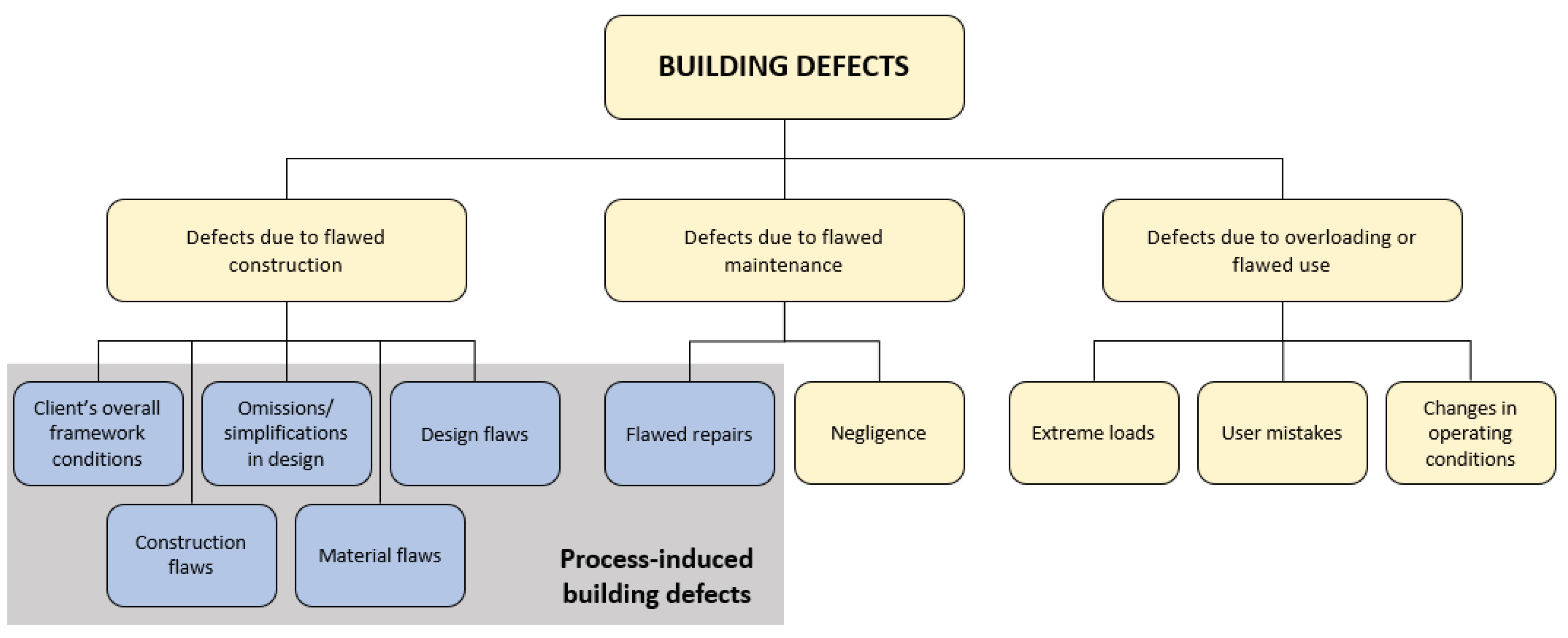
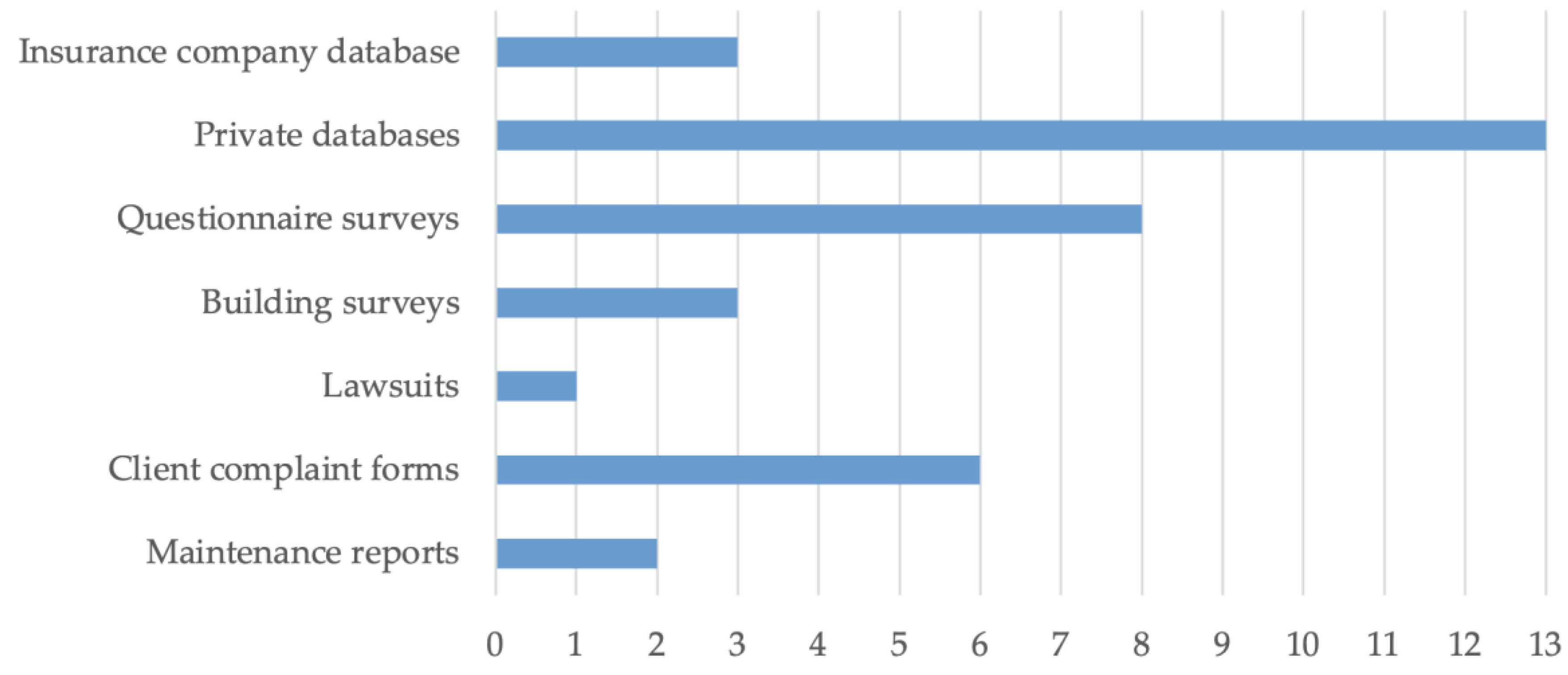
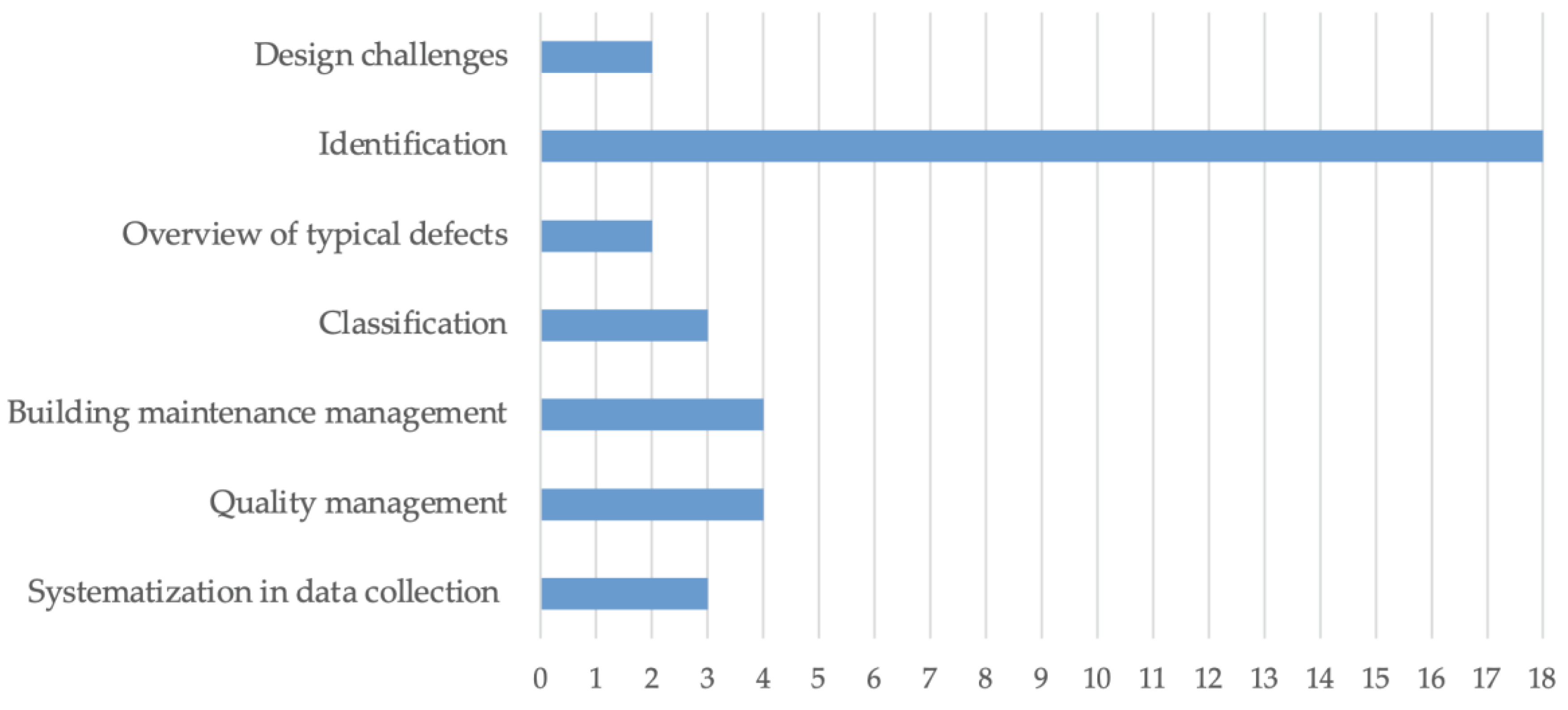
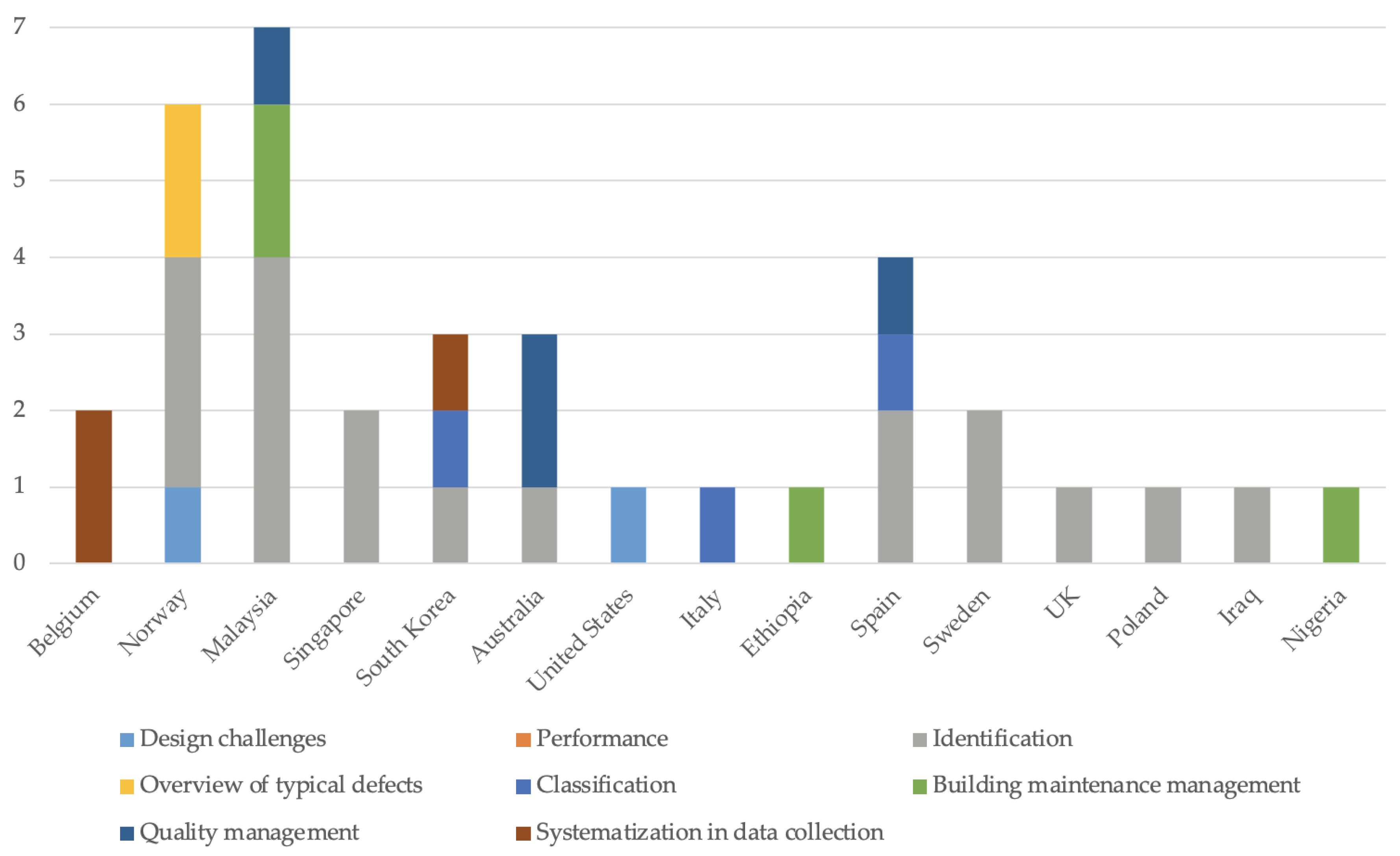
| Number of articles | |||
|---|---|---|---|
| Search string | Web of Science | Scopus | ScienceDirect |
| "Building defects" AND "moisture" | 23 | 21 | 69 |
| "Building defects" AND "water" | 27 | 23 | 135 |
| Category | Description |
|---|---|
| Insurance company databases | The authors have analysed registers with claims from clients seeking compensation for building defects. The data are normally not publicly available. |
| Private databases | These databases are owned, controlled, and maintained by an organization for internal use and are not publicly available. The collectors can be developers, contractors, science organizations, or damage investigators. The authors of these articles have gotten permission to access and analyse the cases anonymously. |
| Questionnaire surveys | The authors have distributed questionnaires to potential respondents for a specific study. |
| Building surveys | The authors have conducted surveys in the buildings by themselves for a specific study. |
| Lawsuits | The authors have studied the public descriptions of judgements and analysed the data. |
| Client complaint forms | The authors have analysed complaints reported by the users/owners and collected by the building owners, developers, or contractors. |
| Maintenance reports | The authors have analysed data reported by the maintenance teams responsible for the buildings. |
| Category | Description |
|---|---|
| Design challenges | These articles refer to certain constructions or solutions and investigate the challenges to these designs. |
| Identification | These articles include the identification of specific elements based on different key issues such as origin, contributing factors, type, risks, relations, and frequency in relation to different periods and types of buildings. |
| Overview of typical defects | These articles aim to get a general overview on the most common building defects. |
| Classification | These articles organize defects based on certain properties. |
| Building maintenance management | These articles focus on gaining information to reduce maintenance costs and to develop strategies to save maintenance expenses. |
| Quality management | These articles involve implementing principles and methods to ensure and improve the quality of buildings. |
| Systematization in datacollection | These articles look at the importance of systematization to gather data so that the identification or classification is more valid. Other articles also have systematically collected data, but these articles aim to emphasize that this is important to achieve good results. |
| Type of Information Source | Ref. | Number of defects | Country | Main Purpose of Study | Period (phase)* |
| Insurance company databases |
[8] | 27,074 | Belgium |
|
1991-2019 (-) |
| [9] | |||||
| [2] | 8,128 | Australia |
|
2011-2018 (-) |
|
| Private databases |
[33] | 175 | Norway |
|
1963-2001 (-) |
| [6] | 2,423 |
|
1993-2002 (-) |
||
| [34] | 302 |
|
1983-2002 (-) |
||
| [35] | 465 |
|
1993-2002 (-) |
||
| [36] | 150 |
|
1993-2017 (-) |
||
| [37] | 42,753 | Australia |
|
2002 (-) |
|
| [38] | Unknown |
|
- | ||
| [39] | 16,701 | South Korea |
|
2008-2017 (Post-handover) |
|
| [40] | 7,554 |
|
2008-2017 (-) |
||
| [10] | 6,087 |
|
2008-2017 (Maintenance phase) |
||
| [41] | 560 | Poland |
|
2018-2020 (Warranty period) |
|
| [13] | 1,105 | Sweden |
|
2014-2021 (-) |
|
| [42] | 1,055 | Malaysia |
|
2009-2019 (-) |
|
| Questionnaire surveys | [43] | 118 | Malaysia |
|
- |
| [44] | 310 |
|
- | ||
| [45] | Unknown |
|
- | ||
| [46] | 63 |
|
- | ||
| [47] | Unknown |
|
- | ||
| [48] | Unknown | Sweden |
|
- | |
| [49] | Unknown | Nigeria |
|
- | |
| [50] | Unknown | Ethiopia |
|
- | |
| Building surveys | [51] | 6,758 | Iraq |
|
2009-2012 (Post- Handover) |
| [52] | Unknown | Singapore |
|
- (User phase) |
|
| [7] | Unknown |
|
- (User phase) |
||
| Lawsuits | [53] | 222 | Italy |
|
2000-2011 (-) |
| Client complaint forms | [54] | 966 | Spain |
|
- (Post-handover) |
| [55] | 2,351 |
|
2004-2013 (Post-handover) |
||
| [56] | 2,351 |
|
2004-2006 (Post-handover) |
||
| [57] | 52,552 |
|
2012-2017 (Construction and post- handover) |
||
| [58] | 2,047 | Norway |
|
- (Handover) |
|
| [59] | 55,439 | Malaysia |
|
- (User phase) |
|
| Maintenance reports | [60] | 3,209 | United Kingdom |
|
- (User phase) |
| [61] | 2,929 | United States |
|
- (User phase) |
| Type of information source | Number of articles | Min. number of defects | Max. number of defects | Total number of defects |
| Insurance company databases | 3 | 8,128 | 13,068 | 31,114 |
| Private databases | 13 | 150 | 42,753 | 81,288 |
| Questionnaire surveys | 8 | 63 | 310 | 491 |
| Building surveys | 3 | 6,758 | 6,758 | 6,758 |
| Lawsuits | 1 | 222 | 222 | 222 |
| Client complaint forms | 6 | 966 | 55,439 | 115,706 |
| Maintenance reports | 2 | 2,929 | 3,209 | 6,138 |
Disclaimer/Publisher’s Note: The statements, opinions and data contained in all publications are solely those of the individual author(s) and contributor(s) and not of MDPI and/or the editor(s). MDPI and/or the editor(s) disclaim responsibility for any injury to people or property resulting from any ideas, methods, instructions or products referred to in the content. |
© 2024 by the authors. Licensee MDPI, Basel, Switzerland. This article is an open access article distributed under the terms and conditions of the Creative Commons Attribution (CC BY) license (http://creativecommons.org/licenses/by/4.0/).

